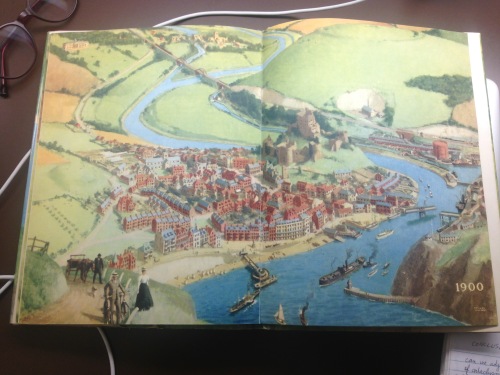
A Valley Grows Up
by Edward Osmond
Age: 10+
Interests: history, British history, architecture, engineering, transportation, warfare, town planning, ancient history, medieval history
Oxford University Press: 1953
82 pages
This is a nonfiction book depicting the changing fortunes of an English valley over the course of seven thousand years, from 5000 BCE to 1900. Frequent double page spreads show the same perspective of the area at different time periods, so the reader can flip from one era to another and note the many changes, in the physical geography and vegetation, the plan of the village streets, the size and nature of the dwellings, the technology of the bridges, and the changing costumes of the people and their methods of travel. (see photos below)
The eras depicted are: Prehistoric (5000 BC), Iron Age (250 BC), Roman (250 AD), Saxon (900 AD), Norman (1160), Early Medieval (1250), Late Medieval (1475), Elizabethan (1600), Georgian (1770), and Victorian (1900).
In between the double page illustrations the author explains the major shifts and politics of each period. There is an awful lot about trades and businesses, the style of homes, building materials, fortresses and armaments, and the rise and fall of farms, monasteries and great estates. Whenever invaders swept through there were massive upheavals, but over time the town would regain its footing and life would go on.
This book is interesting and contains a wealth of historical detail, but is sadly quite dated. The earnest, humourless tone gives it a real school textbook feel. Dry! While I do love the illustrations – I spent a long time flipping back and forth to note the changes – the fact that the setting is imaginary made me wish the author had provided more colour. I mean, if you’re going to invent a lord to live in the castle on the hill, why not flesh him out with a dramatic life story? And a bloody fate? There could have been a lot more imaginative storytelling to bring the villagers, farmers, knights, lords and ladies to life, instead of leaving most of them nameless, faceless and mute.
While not without a certain appeal for history nerds (and perhaps those who are passionate about city planning and engineering), this book is just too dry for mainstream readers today. Which is probably why I could only find it in the Children’s Reference Section of the Vancouver Public Library – I am sure it’s been out of print for a long, long time. Could someone do a more modern take on this concept, please??






